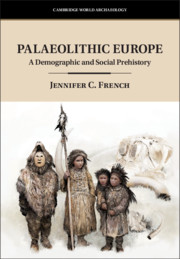Book contents
- Palaeolithic Europe
- Cambridge World Archaeology
- Palaeolithic Europe
- Copyright page
- Dedication
- Contents
- Figures
- Tables
- Text Boxes
- Preface
- Acknowledgements and Permissions
- 1 Towards a Social Palaeodemography of Early Prehistory
- 2 Stones, Bones, and Genes: A Palaeodemographic Database
- 3 Hunter-Gatherer Demography
- 4 Visitation: The First European Populations (~1.8 million–300,000 years ago)
- 5 Residency: The Neanderthals and Their Neighbours (~300,000–40,000 years ago)
- 6 Expansion: The Arrival of Homo sapiens in Europe and the Extinction of the Neanderthals (~50,000–35,000 years ago)
- 7 Intensification: Mid-to-Late Upper Palaeolithic Population Dynamics (~35,000–15,000 years ago)
- Chapter 8 Palaeolithic Europe: Demography and Society
- Glossary
- References
- Index
1 - Towards a Social Palaeodemography of Early Prehistory
Published online by Cambridge University Press: 27 October 2021
- Palaeolithic Europe
- Cambridge World Archaeology
- Palaeolithic Europe
- Copyright page
- Dedication
- Contents
- Figures
- Tables
- Text Boxes
- Preface
- Acknowledgements and Permissions
- 1 Towards a Social Palaeodemography of Early Prehistory
- 2 Stones, Bones, and Genes: A Palaeodemographic Database
- 3 Hunter-Gatherer Demography
- 4 Visitation: The First European Populations (~1.8 million–300,000 years ago)
- 5 Residency: The Neanderthals and Their Neighbours (~300,000–40,000 years ago)
- 6 Expansion: The Arrival of Homo sapiens in Europe and the Extinction of the Neanderthals (~50,000–35,000 years ago)
- 7 Intensification: Mid-to-Late Upper Palaeolithic Population Dynamics (~35,000–15,000 years ago)
- Chapter 8 Palaeolithic Europe: Demography and Society
- Glossary
- References
- Index
Summary
Chapter 1 introduces the key issues in Palaeolithic palaeodemography, the four-stage model of the demographic prehistory of Palaeolithic Europe developed in this book, and the social approach adopted which focuses on the role of women and children as drivers of population change, and the distinction between small and small-scale societies.
- Type
- Chapter
- Information
- Palaeolithic EuropeA Demographic and Social Prehistory, pp. 1 - 18Publisher: Cambridge University PressPrint publication year: 2021



